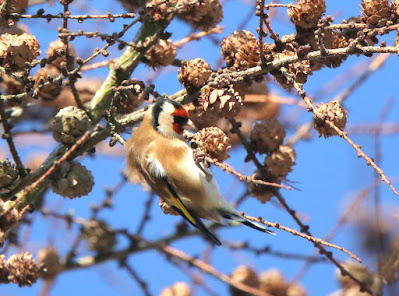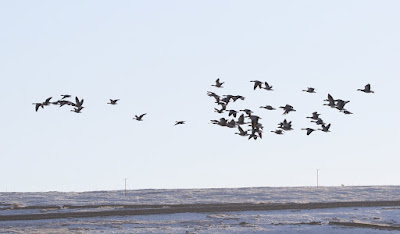Several Goldfinch in the Alders
Mistle Thrushes in the fields
3 active Snipe together
Reservoir only 10% frozen
Here come the Greylags
279 arrived onto the water.
4 distant Teal
Busy water
90% Common gull today.
Greylags starting to leave to roost.
Early afternoon at Leeshaw was pleasant in the sun with clear blue skies on a light N>3 at minus 2 degrees. Only 10% of the reservoir frozen meaning a good chance of turning up the wildfowl with most other local sites frozen. Still no access to the reservoir by car with the track well frozen.
Several Goldfinch were in the Alders at the side of where I parked with Wrens and Dunnocks in the dry stone walls below. A group of Mistle Thrush were in the reservoir banking field but no winter thrushes today, whilst 3 Snipe launched out of the same field and flew over very fast to land in a field near the beck but out of sight.
A frost free field near the farm held Pheasants, Grey Partridge and Lapwings as well as the usual Woodpigs and Starlings.
As I approached the reservoir I could hear the noisy Greylags on their way, then making a splendid sight and sound as they appeared over the hill and landed on the water. After spending 30 minutes preening on the water and feeding on the bank they started leaving >S in small groups heading for a roost somewhere.
Otherwise the water held Canadas, Mallard,Teal and around 150 small gulls, these being 90% Commons.
For me now, with Iceland and Med gull in mind, as well as winter wildfowl, including Smew when the Goosanders start arriving, its a matter of concentrating on Leeshaw, Ogden and Mixenden, the latter being when the ice thaws. I,ll still be keeping an eye on Fly Flatts though its a quiet time up there until late February, it having very acidic water due to the peat so no fish or weed to hold wildfowl which can drop in but very soon leave again.
LEESHAW
279 Greylag
8 Canada
12 Mallard
4 Teal
3 Lapwing
c 150 small gulls, mainly Commons
3 Snipe
14 Mistle Thrush
3 Grey Partridge
19 Pheasant
15 Goldfinch
+ usual sp.
BS

























